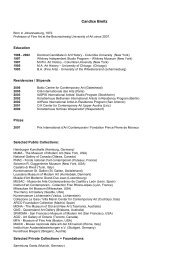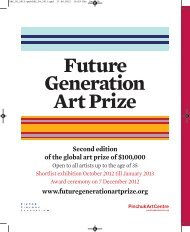Download pdf catalogue - PinchukArtCentre
Download pdf catalogue - PinchukArtCentre
Download pdf catalogue - PinchukArtCentre
Create successful ePaper yourself
Turn your PDF publications into a flip-book with our unique Google optimized e-Paper software.
The extent to which Hirst’s art traverses, to intense moral purpose,<br />
the perceived boundaries between ‘the serious jest’ (to borrow<br />
Goethe’s description of his moral allegory, ‘Faust’) and a sepulchral,<br />
meditational stillness can be seen in the works he has made using<br />
medical equipment, clinical fixtures and drugs. ‘Where There’s a<br />
Will, There’s a Way’ (2007) comprises a white stainless-steel frame,<br />
housing stark metal shelves on which are set neat identical clusters<br />
of the antiretroviral pills used to treat HIV/AIDS. Also referring<br />
to charity (in early 2008 Hirst conceived and organised a major<br />
auction of works by leading artists, all the proceeds of which were<br />
used to assist people suffering from HIV/AIDS), ‘Where There’s<br />
a Will, There’s a Way’ is accompanied by one of the artist’s Fact<br />
Paintings (the generic title Hirst gives to his paintings made from<br />
photographs), ‘HIV AIDS, Drugs Combination’ (2007), depicting<br />
an outstretched hand, in the open palm of which are the same<br />
three drugs as are grouped in the cabinet. Together, these works<br />
conflate a form of social realistic figuration with Hirst’s distinctive<br />
and chilling use of medical and scientific imagery. The aesthetics<br />
of the clinical environment and the drugs cabinet are thus set<br />
against the traditional visual language of a framed painting. This<br />
creates an effect which is at once visually elegant in its neatness<br />
and use of multiple items, and disquieting in the subtly morbid<br />
coldness of the ranged pills. One might be looking at jewels,<br />
or a pictorial representation of a remaining span of human life,<br />
measured out in the drugs by which it will be maintained.<br />
An analogous piece to ‘Where There’s a Will, There’s a Way’ might<br />
be ‘Purgatory’ (2008), in which a similar framing and shelving<br />
device (yet imperially gold-plated) is used to house hundreds of<br />
cigarette and cigar stubs. The dangers to health of smoking tobacco<br />
are suddenly thrown into a new configuration. As positioned by<br />
the portentous, theological title of the work, the cigarette and cigar<br />
ends seem to articulate despair, and ironically to enshrine a material<br />
record of addiction and compromised mortality.<br />
The deft conflation in Hirst’s art of scientific and aesthetic systems<br />
tends always to create a further layer of mystery and inscrutability<br />
to the work, a quality that is at once futuristic and elegaic, sinister<br />
and melancholy. ‘Night of the Long Knives’ (2008) (the title,<br />
ominously, a seeming reference to a Hitlerite purge within the<br />
Nazi party in 1934) is both an example of such aesthetic qualities,<br />
and also a demonstration of Hirst’s relationship to sculptural<br />
materials and forms. A six-panelled set of stainless-steel and glass<br />
cabinets, its shelves filled with neatly arranged surgical equipment,<br />
‘Night of the Long Knives’ is at once chilling and compelling; the<br />
viewer is similarly drawn to the tactile nature of the work, and its<br />
acoustic presence. In its order and precision, this is a work which<br />
implies there is a tension between fragility and chaos, delicacy and<br />
struggle. Most directly, it speaks to the viewer of the reality of<br />
surgery – a process which remains, for the most part, hidden behind<br />
the white internal shutters of general anaesthetic.<br />
Hirst’s exploration of mortality, and, more important, the human<br />
ability to conceive mortality as a fact, might be seen as the basis<br />
of his art. The awareness of death and the lifelong process of dying<br />
are themes which run throughout his work. But this concentration<br />
on mortality is matched and framed by an equivalent fascination<br />
with dramatic spectacle, awe and wonder – qualities which within<br />
classic romantic art would fall within the constitution of the<br />
sublime. Hirst’s art merges sublime spectacle with not only allegories<br />
of mortality, but also direct representations of death’s reality, and<br />
the vulnerability of the body. In the art of Damien Hirst, as in the<br />
art of Francis Bacon, the body is often depicted in vexed and<br />
contorted corporeality.<br />
‘Death Explained’ (2007) comprises a mature shark bisected down<br />
its length, and the two halves placed in matching steel and glass<br />
tanks, which stand side by side. This work is shown in an installation<br />
with his ‘Death Denied’, comprising a single shark, which is the<br />
same length as the one in ‘Death Explained’. Together, these two<br />
works are part of a two-work series entitled: ‘Coming to Terms<br />
with and Trying to Understand the Complexity of Feelings and<br />
Ever Changing Fears and Doubts that Every Human Being<br />
Experiences when Faced Every Moment with the Unfathomable<br />
Uncertainties of Death’. This work refers in part to the now mythic<br />
iconography of Hirst’s own art making – notably to his sculpture<br />
‘The Physical Impossibility of Death in the Mind of Someone<br />
Living’ (1992), in which, famously, a shark was placed in a tank<br />
of formaldehyde. In the work comprising ‘Death Explained’ and<br />
‘Death Denied’ we see a similar ensemble of media articulating<br />
the same human consciousness of mortality. The reality of our<br />
brief, fragile and unpredictable residency on Earth is spelt out with<br />
the same directness – part illustration, part fable – that can be<br />
found in pre-Christian or tribal art.<br />
Throughout the art of Damien Hirst there exists a primal power<br />
of the sort identified by the illustrious art historian E.H. Gombrich<br />
at the beginning of his classic book ‘The Story of Art’ (1950): “We<br />
cannot hope to understand these strange beginnings of art unless<br />
we try to enter the mind of the primitive peoples and find out<br />
what kind of experience it is which makes them think of pictures,<br />
not as something nice to look at, but as something powerful to<br />
use. I do not think it is really so difficult to recapture this feeling.<br />
All that is needed is the will to be absolutely honest with ourselves,<br />
and see whether we, too, do not retain something of the ‘primitive’<br />
in us. Instead of beginning with the Ice Age, let us begin with<br />
ourselves.” Such a founding statement of analysis and intent could<br />
be said to describe precisely the urgency and force of the art of<br />
Damien Hirst.<br />
The nature of spectacle in Hirst’s art is profound. There is a sense<br />
in which Hirst, quite simply, wants his art to take the viewer’s<br />
breath away – to leave them astounded and awed. (Hirst has<br />
remarked that he would like to create a rainbow in a gallery; also,<br />
that he considers a perfect white sphere to be an ideal piece of art.)<br />
This understanding of showmanship, and the use of spectacle<br />
as a medium for art making, allows Hirst not simply to engage<br />
with the viewer in a direct, highly emotive way, but also to play<br />
conceptual, artistic and thematic games with the relationship<br />
between spectacle and empathy.<br />
In an age when visual culture is ubiquitous, multimedia and<br />
monumental, Hirst creates an art which is simultaneously refined,<br />
poetic and declamatory. His art is precisely balanced between a<br />
cold stillness, redolent of scientific technology, and the most vivid<br />
depictions, in terms of both religion and natural science, of the<br />
transience of life. This second component of his artistic language<br />
is particularly pronounced in the works Hirst has made using<br />
butterflies and butterfly wings. In Requiem there are several major<br />
examples of these works, including the seven-panel butterflies on<br />
household gloss on canvas, ‘Ariel’ (2006) (titled after the poem by<br />
Sylvia Plath), and the six panels, butterflies and household gloss<br />
on canvas, ‘Six Lovely Months’ (2008). These two works are<br />
perhaps the most formally simple of Hirst’s butterfly pieces, and<br />
they establish a powerful visual tension between the frailty and<br />
exquisite colours of the butterflies, and the somewhat drab, industrial<br />
colours (like shades of car paint) of the household gloss backgrounds<br />
on which they are fastened. The effect is both museological and<br />
poetic: the sense of a tiny life arrested, and of a transient, short<br />
lived beauty. It is typical of Hirst’s acuity to work with a medium<br />
– in this case butterflies – that is poetic and laden with symbolic<br />
meanings in itself; the medium becomes the meaning of the work,<br />
its language heightened.<br />
Historically, in Greek, Celtic, early Christian and Chinese<br />
mythology, the butterfly has been regarded a symbol of the soul.<br />
Indeed, ‘Psyche’ is the Greek word for both ‘the soul’ and ‘butterfly’,<br />
giving rise to the notion that human souls become butterflies while<br />
seeking reincarnation. In some Christian symbolism, also, Christ<br />
is depicted with a butterfly in His palm. Such mythological and<br />
religious or spiritual underpinning seems in place in Hirst’s butterfly<br />
work ‘Karma’ (2008) – with its reference to the accumulation and<br />
exchange of a soul’s moral balance – and the brilliantly patterned<br />
triptych ‘Doorways to the Kingdom of Heaven’ (2007), based on<br />
the extravagant design of cathedral windows. (Hirst has also made<br />
several butterfly paintings titled after specific psalms.)<br />
Hirst makes work which mixes media – his paintings can contain<br />
other elements, just as some of his sculpture shares aspects of<br />
painting. In a manner comparable to that of Marcel Duchamp<br />
and Richard Hamilton, the art of Damien Hirst is conceptually<br />
driven to seek the most effective and original form for each individual<br />
idea. Unique to Hirst, however, is the constant interplay and<br />
reference between different works and series of works. It is as<br />
though he brings an idea to life, and then allows it to run and<br />
develop through the continuing progress of his art. This brings<br />
aspects of different works into sudden conflation, as well as looping<br />
back to re-engage retrospectively with what has become the art<br />
historical iconography of his earlier themes or motifs.<br />
‘Beautiful Explosion of Vanity Painting (with butterflies)’ (2007)<br />
combines Hirst’s iconic spin painting style with the motif of his<br />
butterfly paintings. These spin paintings with skull images on them<br />
are titled in a specific way: they start with ‘Beautiful’ and end with<br />
‘Painting’, and have the name of a god and an altered state in<br />
the title. Thus, if there are four skulls on the same painting,<br />
there are four altered states and four gods. The result is a layered<br />
effect – a density of Hirstian qualities, as though to concentrate<br />
the very qualities, thematic and stylistic, for which the artist<br />
has become so famous. There is a richness of mood to these<br />
works, which combine various aspects of Hirst’s aesthetic,<br />
and introduce an epic scale.<br />
In ‘Beautiful Zeus Maia Freya Isis Meditative Hysterical Sensory-<br />
Deprived Dream Painting’ (2007), for example, the dramatic<br />
vortices of paint (at once reminiscent of acceleration and cyclone)<br />
which typify Hirst’s spin paintings is encoded with four human<br />
skull motifs – which in their turn bring to mind Hirst’s various<br />
works with human skulls, and most notably perhaps his ‘For the<br />
Love of God’ (2006). At once graphic, monumental and touched<br />
with the spirit of Pop Art (the repeated skulls have a Warholian<br />
vacuity to their empty yet pointed gaze), this enormous canvas<br />
appears to be descended from a tradition of dramatic, ‘visionary’<br />
painting. There is a quality of biblical revelation to the manner<br />
in which the skulls appear to be manifest within a revolutionised<br />
cosmos. At the same time, as the title of the work suggests, there<br />
is a feeling of troubled dreamscape to the painting.<br />
Hirst’s paintings appear at once intensely crafted and imbued<br />
with a mechanistic impersonality. Some combine abstraction and<br />
figuration, as can be seen in the series of skull paintings, for example,<br />
‘Beautiful Minerva Catatonia Painting’ (2007), in which a human<br />
skull sits centrally within the multi-coloured screaming perspective<br />
of a spin painting. These are perhaps the closest Hirst has come<br />
in his painting to pursuing the graphic style of Pop Art. For Hirst,<br />
however, the cool of Pop styling is radically de-stabilised by the<br />
dizzying use of colour to convey movement reaching critical mass.<br />
It is a style which, in terms of Pop Art, might only be compared<br />
to Warhol’s use of ‘camouflage’ in some of his late paintings<br />
and self portraits.<br />
Elsewhere, specifically in the series The Birth Paintings, made by<br />
Hirst in 2006 within the genre of his Fact Paintings, there is an<br />
eerily pale and watery evocation of artificial light, disclosing surgical<br />
wounds and the newly born baby surrounded by darkness. As with<br />
all of Hirst’s Fact Paintings, these works appear both photo-realistic<br />
and traditionally representational – ‘Closing the Wound I, II<br />
and III’ (2006) – an effect which radically heightens, and somehow<br />
renders more raw, the intimate, tender and explicit nature of<br />
their subject matter.<br />
22 23






